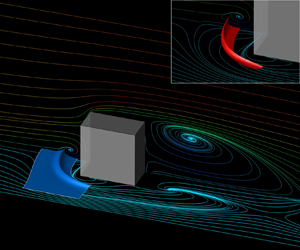No CrossRef data available.
Published online by Cambridge University Press: 22 August 2023

We develop a frame-invariant theory of material spike formation during flow separation over a no-slip boundary in three-dimensional flows with arbitrary time dependence. Based on the exact evolution of the largest principal curvature on near-wall material surfaces, our theory identifies fixed and moving separation. Our approach is effective over short time intervals and admits an instantaneous limit. As a byproduct, we derive explicit formulas for the evolution of the Weingarten map and the principal curvatures of any surface advected by general three-dimensional flows. The material backbone we identify acts first as a precursor and later as the centrepiece of Lagrangian flow separation. We discover previously undetected spiking points and curves where the separation backbones connect to the boundary and provide wall-based analytical formulas for their locations. We illustrate our results on several steady and unsteady flows.